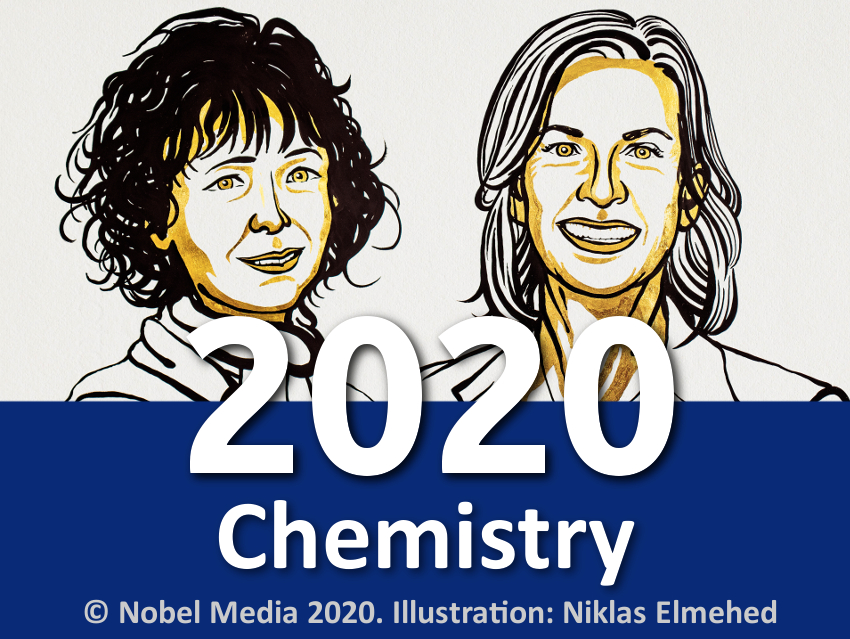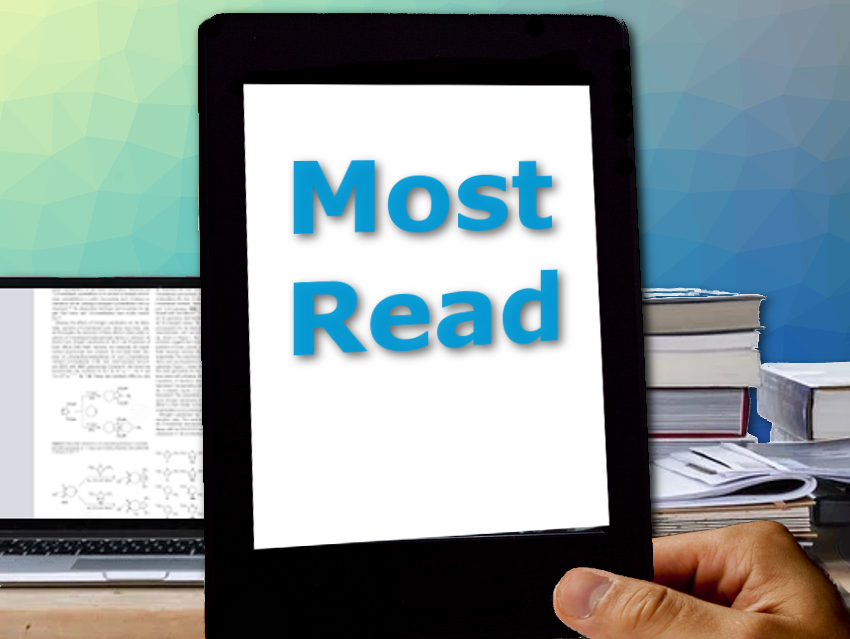The Nobel Prize in Chemistry 2020 has been awarded jointly to
- Emmanuelle Charpentier, Max Planck Unit for the Science of Pathogens, Berlin, Germany,
- Jennifer A. Doudna, University of California, Berkeley, USA,
“for the development of a method for genome editing”.
Research
The Laureates have discovered one of gene technology’s most powerful tools: the CRISPR/Cas9 genetic scissors. Using these, researchers can change the DNA of animals, plants, and microorganisms with extremely high precision. This technology has had a revolutionary impact on the life sciences, is contributing to new cancer therapies, and might help to cure genetic diseases. Modifying genes in cells used to be time-consuming, difficult, and sometimes impossible. Using the CRISPR/Cas9 genetic scissors, it is now possible to change the code of life easily.
Emmanuelle Charpentier studied Streptococcus pyogenes when she discovered a previously unknown molecule, tracrRNA. Her work showed that tracrRNA is part of bacteria’s ancient immune system, CRISPR/Cas. CRISPR refers to repetitive DNA sequences, called “clustered regularly interspaced short palindromic repeats”. There also are special genes that are called “CRISPR-associated”, or “cas”. They encode Cas proteins, which can disarm viruses by cleaving their DNA. The CRISPR system in S. pyogenes only requires a single Cas protein, Cas9, to cleave virus DNA. Charpentier published her discovery of tracrRNA in 2011.
The same year, she initiated a collaboration with Jennifer Doudna. Together, they succeeded in recreating the bacteria’s genetic scissors in a test tube and simplifying the scissors’ molecular components so they are easier to use. They fused tracrRNA and CRISPR-RNA into a single molecule, which they named guide RNA. With this guide RNA, the scissors can be controlled so that they can cut any DNA molecule at a predetermined site. Where the DNA is cut, it is then easy to rewrite the code of life using the cell’s natural systems for DNA repair.
Since Charpentier and Doudna discovered the CRISPR/Cas9 genetic scissors in 2012, their use has exploded. This tool has contributed to many important discoveries in basic research and medicine.
Laureates
Emmanuelle Charpentier, born in Juvisy-Sur-Orge, France, in 1968, studied biochemistry, microbiology, and genetics at the Pierre and Marie Curie University (today the Faculty of Science of Sorbonne University), Paris, France, and gained her Ph.D. from the Institut Pasteur, France, in 1995 investigating molecular mechanisms involved in antibiotic resistance. After positions as a university teaching assistant at Marie Curie University from 1993 to 1995, as a postdoctoral fellow at the Institut Pasteur from 1995 to 1996, as a postdoctoral fellow at the Rockefeller University, New York, NY, USA, from 1996 to 1997, as an assistant research scientist at the New York University Medical Center, NY, USA, from 1997 to 1999, as a research associate at the St. Jude Children’s Research Hospital, Memphis, Tennessee, USA, and the Skirball Institute of Biomolecular Medicine, New York, USA, from 1999 to 2002, she became lab head and a guest professor at the Institute of Microbiology and Genetics, University of Vienna, Austria, from 2002 to 2004. From 2004 to 2006, she was lab head and an assistant professor at the Department of Microbiology and Immunobiology, and in 2006, a private docent and received her habilitation at the Centre of Molecular Biology. From 2006 to 2009, she worked as a lab head and associate professor at the Max F. Perutz Laboratories, Vienna, Austria.
From 2009 to 2014, Charpentier was lab head and an associate professor at the Laboratory for Molecular Infection Medicine Sweden (MIMS), at Umeå University, Sweden. She was promoted to lab head as visiting professor in 2014. From 2013 to 2015, she was a department head and a professor at the Helmholtz Centre for Infection Research in Braunschweig and the Hannover Medical School, both Germany. In 2014 she became an Alexander von Humboldt Professor.
In 2015, Charpentier became a scientific member of the German Max Planck Society and the director at the Max Planck Institute for Infection Biology in Berlin, Germany. Since 2016, she is an Honorary Professor at Humboldt University in Berlin, and since 2018, she is the Founding and Acting Director of the Max Planck Unit for the Science of Pathogens.
Among many other honors, she received the Wolf Prize in Medicine jointly with Jennifer Doudna in 2020, the Kavli Prize in Nanoscience in 2018, the Pour le Mérite in 2017, the Gottfried Wilhelm Leibniz Prize in 2016, and the Breakthrough Prize in Life Sciences 2015.
Jennifer A. Doudna, born in Washington, D.C, USA, in 1964, studied biochemistry at Pomona College, Claremont, CA, USA, and gained her Ph.D. from Harvard Medical School, Boston, USA, in 1989. Her Ph.D. dissertation was on a system that increased the efficiency of a self-replicating catalytic RNA and was supervised by Jack W. Szostak. From 1989 to 1991, she held research fellowships in molecular biology at the Massachusetts General Hospital and in genetics at Harvard Medical School. From 1991 to 1994, she was Lucille P. Markey Postdoctoral Scholar in Biomedical Science at the University of Colorado Boulder, USA. Doudna was promoted to the position of Henry Ford II Professor of Molecular Biophysics and Biochemistry at Yale University, New Haven, Connecticut, USA, in 2000. In 2000–2001, she was Robert Burns Woodward Visiting Professor of Chemistry at Harvard University, USA. Since 2000, she is a Professor at the University of California, Berkeley, USA, and Investigator, Howard Hughes Medical Institute.
Among many other honors, she received the Wolf Prize in Medicine jointly with Emmanuelle Charpentier in 2020, the Kavli Prize in Nanoscience in 2018, the Japan Prize in 2017, the Breakthrough Prize in Life Sciences in 2015, and the Alan T. Waterman Award in 2000. In 2017, Doudna co-founded the bioengineering tech startup Mammoth Biosciences, San Francisco, CA, USA, focusing on improving access to biosensing tests that address “challenges across healthcare, agriculture, environmental monitoring, biodefense, and more”.
With this first all-women shared Chemistry Nobel Prize, the percentage of female Laureates increases to 3.8 %. Emmanuelle Charpentier was quoted on Twitter: “My wish is that this will provide a positive message to the young girls who would like to follow the path of science, and to show them that women in science can also have an impact through the research that they are performing.”
Due to the coronavirus pandemic, the award ceremony this year will be held via telephone conference on December 10, 2020. The banquet, which usually takes place in Stockholm, Sweden, in December, has been moved to 2021.
Selected Publications by Emmanuelle Charpentier
- CRISPR RNA maturation by trans-encoded small RNA and host factor RNase III,
E. Deltcheva, K. Chylinski, C. M. Sharma, K. Gonzales, Y. Chao, Z. A. Pirzada, M. R. Eckert, J. Vogel, E. Charpentier,
Nature 2011, 471, 602–607.
https://doi.org/10.1038/nature09886 - Evolution and classification of the CRISPR–Cas systems,
K. S. Makarova, D. H. Haft, R. Barrangou, S. J. J. Brouns, E. Charpentier, P. Horvath, S. Moineau, F. J. M. Mojica, Y. I. Wolf, A. F. Yakunin, J. van der Oost, E. V. Koonin,
Nat. Rev. Microbiol. 2011, 9, 467–477.
https://doi.org/10.1038/nrmicro2577 - An updated evolutionary classification of CRISPR–Cas systems,
K. S. Makarova, Y. I. Wolf, O. S. Alkhnbashi, F. Costa, S. A. Shah, S. J. Saunders, R. Barrangou, S. J. J. Brouns, E. Charpentier, D. H. Haft, P. Horvath, S. Moineau, F. J. M. Mojica, R. M. Terns, M. P. Terns, M. F. White, A. F. Yakunin, R. A. Garrett, J. van der Oost, R. Backofen, E. V. Koonin,
Nat. Rev. Microbiol. 2015, 13, 722–736.
https://doi.org/10.1038/nrmicro3569
Selected Publications by Emmanuelle Charpentier and Jennifer Doudna
- A Programmable Dual-RNA-Guided DNA Endonuclease in Adaptive Bacterial Immunity,
M. Jinek, K. Chylinski, I. Fonfara, M. Hauer, J. A. Doudna, E. Charpentier,
Science 2012, 337, 816–821.
https://doi.org/10.1126/science.1225829 - Structures of Cas9 Endonucleases Reveal RNA-Mediated Conformational Activation,
M. Jinek, F. Jiang, D. W. Taylor, S. H. Sternberg, E. Kaya, E. Ma, C. Anders, M. Hauer, K. Zhou, S. Lin, M. Kaplan, A. T. Iavarone, E. Charpentier, E. Nogales, J. A. Doudna,
Science 2014, 343, 1247997.
https://doi.org/10.1126/science.1247997 - The new frontier of genome engineering with CRISPR-Cas9,
J. A. Doudna, E. Charpentier,
Science 2014, 346, 1258096.
https://doi.org/10.1126/science.1258096
Selected Publications by Jennifer Doudna
- CRISPR-Mediated Modular RNA-Guided Regulation of Transcription in Eukaryotes,
L. A. Gilbert, M. H. Larson, L. Morsut, Z. Liu, G. A. Brar, S. E. Torres, N. Stern-Ginossar, O. Brandman, E. H. Whitehead, J. A. Doudna, W. A. Lim, J. S. Weissman, L. S. Qi,
Cell 2013, 154, 442–451.
https://doi.org/10.1016/j.cell.2013.06.044 - Repurposing CRISPR as an RNA-Guided Platform for Sequence-Specific Control of Gene Expression,
L. S. Qi, M. H. Larson, L. A. Gilbert, J. A. Doudna, J. S. Weissman, A. P. Arkin, W. A. Lim,
Cell 2013, 152, 1173–1183.
https://doi.org/10.1016/j.cell.2013.02.022 - RNA-programmed genome editing in human cells,
M. Jinek, A. East, A. Cheng, S. Lin, E. Ma, J. Doudna,
eLife 2013.
https://doi.org/10.7554/eLife.00471 - Genomes in Focus: Development and Applications of CRISPR-Cas9 Imaging Technologies,
S. C. Knight, R. Tjian, J. A. Doudna,
Angew. Chem. Int. Ed. 2018, 57, 4329–4337.
https://doi.org/10.1002/anie.201709201
Also of Interest
- Nobel Prize in Physics 2020,
ChemistryViews.org 2020.
The prize was awarded with one half to Sir Roger Penrose (UK) and the other half jointly to Reinhard Genzel (Germany) and Andrea Ghez (USA) - Nobel Prize in Physiology or Medicine 2020,
ChemistryViews.org 2020.
The prize was awarded jointly to Harvey J. Alter (USA), Michael Houghton (Canada), and Charles M. Rice (USA) “for the discovery of Hepatitis C virus” - Nobel Prize in Chemistry 2019,
ChemViews Mag. 2019.
The prize was awarded to John B. Goodenough, M. Stanley Whittingham, and Akira Yoshino for the development of lithium-ion batteries - Chemistry Nobel Prize Quiz,
ChemViews Mag. 2019.
How much do you know about the Nobel Prize Laureates? - The Nobel Prize,
Veronika Belusa,
ChemViews Mag. 2015.
Collection of information on the Nobel Prize - Collection: Nobel Prize in Chemistry
Collection of interviews with Nobel Laureates and Nobel Prize quizzes
Videos with the Nobel Laureates directly after the prize announcement First Day in a Nobel Life: Jennifer Doudna
Emmanuelle Charpentier reacts after winning the 2020 Nobel Prize in Chemistry




